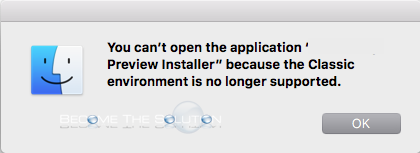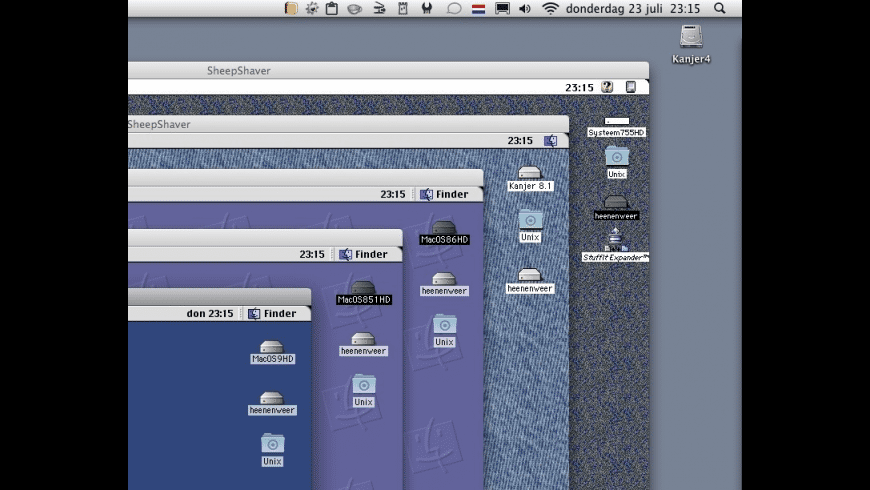
- How do I turn on the Classic Environment on my mac 10.5.8? I need to install Print Shop and it says the Classic - Answered by a verified Mac Support Specialist We use cookies to give you the best possible experience on our website.
- The Classic environment allowed Macintosh software from the pre Mac OS X era to run on Macs using Mac OS X. Classic is not available on Macs with Intel processors or running Mac OS X 10.5 (Leopard).
The Mac OS 9 Lives Forum is dedicated to. Installing, Maintaining, and Extending the functionality of Mac OS 9 Each Section can be Expanded or Compressed by clicking the Title of the section This will shrink the Forum to display Only the Sections you want.
The goal of M.A.C.E. project is the create an runtime library and executing environment for old Mac applications, similar to Apple’s deprecated Classic environment, but without needing any ROM images or System Software binaries by Apple.
Foreword
Ever since the introduction of Mac in 1984, many have been fascinated by the ease of use, friendly interface and approachability of them. Many people who only had experience of computers text-based Apple ][ and IBM-compatible PCs, were blown away by the high-resolution graphical user interface, mouse, windows, icons and everything the Macs offered. Compared to the text-based operating systems such as DOS, the step was huge – especially for kids like us who were just starting to learn English as foreign language, the switch from trying to learn typing bizarre foreign-language commands on a black terminal to a native Finnish-language visual interface, where actions were performed using pointing and clicking, was literally out of this world.
Spending youth in this environment, we grew up to love the original Mac interface, spent (way too many) hours playing the games on them, and eventually learned programming. Throughout the years, we’ve started to miss the great user experience, and games we used to play. Luckily, there also seem to be other people with more or less similar thoughts, as we found about various emulators which allowed running old Mac system software, apps and those games we used to love. The emulators we’ve most had experience have been (links included):
They all have their advantages and drawbacks, but have been the best options available so far.

From a small great idea…
Most of the emulators seemed to suffer though from certain drawbacks; most required copyrighted Apple ROM files, system software images, and transferring files required often joggling around with disk images to get the job done. And like on real Macs, it’s often not obvious which games should be ran of which system; Trying to run very old monochrome games such as Dark Castle will definitely cause problems on Mac OS 9!
Inspired by Apple’s Classic environment on Mac OS X, and further motivated by the discontinuation of it eventually during Intel transition, my friend Pukka had an idea, which turned out to be the seed from which this project was sprung from. As far back as in early 2010, he proposed building a wrapper, where “Classic” 68K Mac apps could be executed, and all their system API calls translated to the modern Carbon equivalents, called “x68k”:
Its a 68k emulator for OS X similar to what older PowerMac System/OS versions have. It is able to run old programs without classic as if they were native. For now it is only able to run simplest kind of applications.
I dont have complete Toolbox emulation (yet). There is 68k processor emulation and wrapper which translates application’s toolbox calls to the Carbon framework calls. Some deprecated functions and features are implemented so that the applications are able to run.
Download Classic Environment For Mac Os X
Sadly, the project eventually stalled due to the limitations and deprecation of Carbon API, previously started transformation Intel, and the eventual 32-bit to 64-bit transition.
…to a new beginning!
During the late 2017, I ended up chatting with Pukka, and somehow the idea of restarting the project came up. I decided I would attempt to build a completely fresh Toolbox implementation for him. Unlike the existing emulators, which are focused on emulating the hardware and using existing copyrighted ROM and operating system binaries, this project would have the benefit of being completely free of any ROM or Mac system files, with all Toolbox APIs implemented in C code, translated on the fly to the host system!
This website documents the journey we began, which could eventually lead to the ability for us to play the beloved old games, such as Dark Castle, Railroad Tycoon, and Civilization again on any modern operating systems.
Home > Articles
␡- The Classic Environment
This chapter is from the book
This chapter is from the book
In This Chapter
Download Mac Classic Environment Download
- The Classic Environment
- Launching Classic
- The Boot Process
- Running Classic Applications
- Maintaining and Monitoring Classic
- Direct Booting Mac OS 9.x
If you've never had a Mac or are a NeXT user who's happy to have finally found a home, Mac OS X probably has more than enough available software and functionality to make you happy. Those of you who have been using the Mac operating system regularly for years, however, are likely to already have a software library that you rely on. To accommodate this need, Apple included the Classic environment. Classic provides a runtime layer for older, non-Carbonized Mac applications. It even allows certain pieces of hardware to be accessible, such as USB scanners and cameras. It is not a perfect solution, but it does allow for a high degree of compatibility with legacy hardware and software from within Mac OS X.
This chapter looks at the Classic environment, how it works, how to configure it, and what to do if you absolutely must boot into Mac OS 9.x.
The Classic Environment
As defined in Chapter 1, 'Mac OS X Component Architecture,' the Classic environment is a complete implementation of Mac OS 9.x on top of Mac OS X. To Mac OS X, Classic is nothing but another application; to a user, however, Classic is a gateway to his older software programs.
TIP
You must have at least 128MB of memory to use Classic, and a 400MHz G3 (or faster) is recommended. When it comes to Classic, more is definitely better.
Classic is a process under Mac OS X. Mac OS X must be running for Classic to work. In essence, you're booting two operating systems simultaneously.
When using the Classic environment, the 9.x operating system must access all hardware through the Mac OS X kernel. This means software that accesses hardware directly will fail. Users of 3Dfx video cards, hardware DVD playback, video capture cards, and even some CD writers will find that their hardware no longer functions correctly.
On the other hand, Classic brings the benefit of Mac OS X's virtual memory underpinnings to legacy applications. Each Mac OS 9.x application can be configured for a much larger memory partition than was possible previously. To the Classic environment, the virtual memory appears to be real memory. Programs have much more breathing room in which to function.
Working with the Classic environment is a somewhat unusual experience. Depending on the application running, there can be graphic anomalies and confusing file system navigation. This chapter will show what you'll see and what to do when things don't seem to work right.

Related Resources
- Book $55.99

- eBook (Watermarked) $55.99
- Web Edition $55.99
